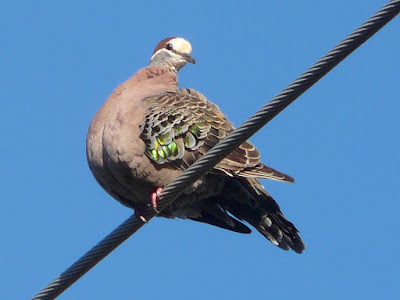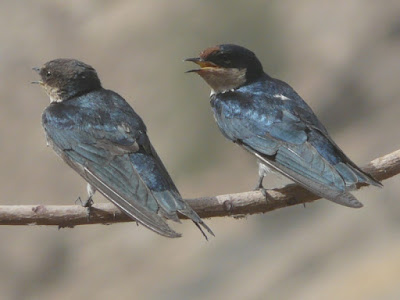This is another in the sporadic series on colour in nature. You can find the most recent one here and trace it back therefrom. However for this particular installment you might also like to cast a glance at the first posting on blue in nature; the reason for this is that iridescent colours - where parts of an animal appear to shine, and even to change colour with a slight change of viewing angle - are formed in somewhat similar ways to blue (and combinations of blue, such as give yellow and purple). The colours have nothing to do with pigments, but are down to structures in the feather or skin of the animal, which reflect certain wavelengths.
However while non-iridescent blue for instance is always the same blue from any angle, iridescent structures give varying colours and rely on layers of cells that have different light-reflecting or refracting properties. We see the different colours by looking at different angles, and seeing light coming from the different surfaces. Moreover subtle aspects of these adjacent layers can cause effects to be reinforced or neutralised. Iridescence relies crucially on a reflecting base layer of melanin, or the light just keeps going through.
An oil layer on water produces similar effects, with light reflecting back from the bottom surface and the top one, creating a rainbow effect as light wavelengths suppress or reinforce each other. (The word is based on Greek iris, a rainbow.)
For a more thorough analysis of the basis of the phenomenon in nature, this is a very comprehensive review.
 |
| Iridescent speculum in the wing of the Australian Pacific Black Duck Anas superciliosus.The photos above and below were of the same bird, taken just seconds apart. |
It seems that iridescence can be used by species to convey information about the individual which includes sex, age, fitness as a mate, fitness to defend territory against an intruder and even species identification for very similar species. It may also play a role in camouflage (breaking up outlines, or in underwater situations), scare or confuse predators, for instance by making it hard to judge the exact distance to the prey, or by alternately flashing and hiding wing patterns in flight. Blues, purples, greens and bronze dominate iridescent colours.
But for the rest of today, let's just enjoy some examples of iridescence in bird feathers - leaving aside for now just one very important family which employs iridescence so comprehensively that they warrant their own posting next time. Let's continue with ducks, which are significant employers of the technique, on heads and backs as well as in wing speculums.
| Feral Mallard Anas platyrhynchos, Canberra. |
 |
| Chiloé Wigeons Anas sibilatrix, Puerto Natales, Chile. The male is on the right. |
 |
| Male Muscovy Duck Cairina moschata, Manu NP, Peru. Even in the dull rainforest light which is my excuse for a poor photo, the iridescent back gleams. |
| Mandarin Duck Aix galericulata, Taronga Park Zoo, Sydney. |
The most widespread ibis in the world is the iridescent Glossy Ibis Plegadis falcinellus, but it is not the only iridescent ibis.
 |
| Glossy Ibis, Jerrabomberra Wetlands, Canberra. |
 |
| Hadada Ibis Bostrychia hagedash, Queen Elizabeth National Park, Uganda. A very familiar African bird, named for its compellingly loud call. |
 |
| Austral Parakeet Enicognathus ferrugineus, Cuevo del Milodon, southern Chile. The lightly iridescent head of this parrot is found further south than any other parrot's, to very tip of South America. |
 |
| Common Bronzewing Phaps chalcoptera, Canberra.A very common bird, including in urban situations, across most of Australia. |
| Spinifex Pigeon Geophaps plumifera, central Australia. The similarity of the display of these two species is striking. |
 |
| Squatter Pigeon Geophaps scripta, Mareeba, Queensland. |
 |
| Common Starling Sturnus vulgaris, Canberra. An unwelcome exotic here, but the green to purple iridescence of the breast is still striking. |
 |
| Greater Blue-eared Glossy Starling Lamprotornis chalybaeus, one of the many stunningly iridescent African starlings. |
 |
| Ethiopian Swallows Hirundo aethiopica, Waza NP, northern Cameroon. Many swallows show such iridescence. |
| |
| The green iridescent sheen of the wing covers of the male Great Frigatebird Fregata minor is one feature that distinguishes it from similar species. Here on Genovesa, Galápagos. |
 |
| Leaden Flycatcher male Myiagra rubecula, Canberra. This familiar bird catching the light took me by surprise; in most lights it's a more sombre and well, leaden colour. |
 |
| Malachite Kingfisher Alcedo cristata, Lake Mburo NP, Uganda. Kingfishers also commonly display iridescence, but I especially love the highlights of this one. |
| Masked Flowerpiercer Diglossa cyanea, Yanacocha Reserver, Ecuador. These lovely birds 'cheat' by stabbing the base of a flower to steal nectar without offering pollination services. |
 |
| Shining Bronze-Cuckoo Chrysococcyx lucidus, Canberra, one of the world's smallest cuckoos. All bronze-cuckoos have the strikingly iridescent wings. |
 |
| Superb Fairy-wren Malurus cyaneus, Canberra. One of south-east Australia's most familiar and loved birds whose iridescence is often not recognised - until the sun catches them and 'flash'! |
I'm off again for a couple of weeks, but will then be back for a while with hopefully lots of natural history blogging material.
MEANTIME I'LL LEAVE SOMETHING MORE FOR YOU ON IRIDESCENCE, FEATURING THE AMAZING HUMMINGBIRDS, ON SATURDAY 13 JUNE.
